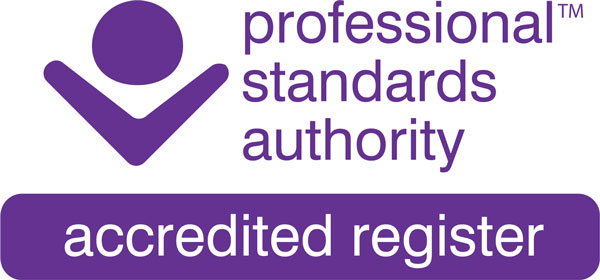A fast treatment for trauma and phobias – evidence for the rewind technique
Counsellors who use it know that the rewind technique is fast, safe, painless and effective for dealing with trauma. Keith Guy and Nicola Guy devised a study to test it.
“THE treatment was like magic.” These were the words of a euphoric client after treatment with Keith for symptoms of trauma which had been affecting his life for the past three months. He worked as a gravedigger and had been present during an exhumation. He was plagued by the memory of a dead face grinning at him and of having to handle and walk through a decaying corpse.
“I had started to get nightmares. I didn’t sleep very well and I had flashbacks at night. Or, when mowing the grass, something would trigger off the incident,” he said. In just one session, using the rewind technique, the panic and anxiety which had dogged him was gone. “I went from not being able to function to functioning. It took the fear and anxiety away.”
It is reactions like this, repeated by client after client (see case study), that made us so keen for the rewind treatment to become better known and widely available. Our study into its effectiveness is, we hope, a first step that will encourage other researchers to test it more rigorously, preferably against other forms of therapy, so that the benefit of rewind can be more forcefully communicated to the thousands of practitioners who still need to know about it.
Although Keith had long had an interest in working with trauma and was trained and experienced in using the debriefing model devised by psychologist and former firefighter Jeff Mitchell, it was only when he learned the rewind technique at a MindFields College (now Human Givens College) workshop that he realised trauma could be treated both quickly and reliably, with the minimum of distress to sufferers.
Debriefing, of which there are now many versions, was designed as a group technique, in which trauma victims were encouraged to talk through their experience and impressions of the trauma, with the debriefer guiding them in their exploration of associated facts, thoughts and feelings. Many elements of the debriefing have repeatedly been called into question, including the tendency to offer it very quickly after a traumatic incident occurred. It is always inappropriate to attempt to debrief people who are highly aroused or distressed. Also, as international trauma expert Noreen Tehrani has pointed out, group debrief sessions may be harmful to highly imaginative participants, who become traumatised by the visualisation of others’ experiences, and are unlikely to help those with severe trauma reactions.1 However, just as worryingly, many debriefers have simply adapted group debrief models for individual use. The rewind technique, in contrast, does not require people to go into detail about their experience in order to neutralise its impact and, we have found, is consistently effective.
How it works
The rewind technique, also known as the fast phobia cure, evolved from the technique developed by Richard Bandler one of the co-founders of Neuro Linguistic Programming (NLP). He called it the VK dissociation technique (the V stands for visual and the K for kinaesthetic — feelings). The version recommended by the Human Givens Institute has been refined and streamlined, as a result of its own research into why and how best it works.2 It is highly useful for individuals who, after exposure to traumatic events, have developed PTSD or lesser forms of the condition. When Keith began practising the rewind technique with traumatised clients, he found it consistently effective, almost immediately.
Simply described, the technique works by allowing the traumatised individual, whilst in a safe relaxed state, to reprocess the traumatic memory so that it becomes stored as an ‘ordinary’, albeit unpleasant, and non- threatening memory rather than one that continually activates a terror response. This is achieved by enabling the coding of the memory to be shifted in the brain from the amygdala to the cerebral cortex.
One of the amygdala’s roles is to alert us to danger and stimulate the body’s ‘fight or fight’ reaction. Normally, all initial sensations associated with a threatening experience are passed to the amygdala and formed into a sensory memory, which in turn is passed on to another brain structure, called the hippocampus, and from there to the cerebral cortex, where it is translated into a verbal or narrative memory and stored. When an event appears life-threatening, however, there can be sudden information overload and the sensory memories stay trapped in the amygdala instead of being passed on to, and made sense of by, the hippocampus. While trapped in the amygdala, the trauma memory has no identifiable meaning. It cannot be described, only re-experienced in some sensory form, such as panic attacks or flashbacks. The rewind technique allows that sensory memory to be converted into narrative, and be put into perspective.
The Rewind Technique
The rewind technique should be carried out by an experienced practitioner and should only be performed once a person is in a state of deep relaxation.
Once fully relaxed, they are encouraged to bring their anxiety to the surface and then are calmed down again by being guided to recall or imagine a place where they feel totally safe and at ease. Their relaxed state is then deepened and they are asked to imagine that, in their special safe place, they have a TV set or other device with a screen, and a remote control.
They are asked to imagine floating, out of body, up behind the screen and to watch themselves watching the screen, without actually seeing the picture (something called double disassociation, a means of distancing them even further from the traumatic memory). They watch themselves watching a ‘film’ of the traumatic event that is still affecting them. The film begins at a point before the trauma occurred and ends at a point at which the trauma is over.
They are then asked, in their imagination, to float back into their body and experience themselves going swiftly backwards through the trauma, from end point to start point, as if they were a character in a film that is being rewound. They then watch the same images but as if on a TV screen while pressing the fast-forward button (disassociation). All this is repeated back and forth, at whatever speed feels comfortable, and as many times as needed, till the scenes evoke no emotion from the client.
If the feared circumstance is one that will be confronted again in the future – for instance, driving a car or using a lift – the person is asked, while still relaxed, to see themselves doing so confidently.
Besides being safe, quick, and painless, the technique has the advantage of being non-voyeuristic. Intimate details do not have to be made public.
Rewind technique? What’s that?
We were both so impressed by Keith’s initial results when working with the technique that we were quite stunned to discover rewind was not used routinely in the UK to treat trauma. We carried out a literature review and found only one research paper, which appeared in the British Journal of Clinical Psychology in 1991 and was an account of a very successful use of rewind with traumatised officers in the West Midlands police force.[3] An internet search found only one UK practitioner, a UK-based American GP, Dr David Muss, who was involved in trauma work and was the author of the one research paper we had found. We next telephoned the main trauma hospitals including The Maudsley in South London and various hospitals in the Priory group, which specialise in treating post-traumatic stress. None of them was using rewind. Finally, we contacted police forces, fire services and occupational health services in seven counties and none had even heard of it.
It would seem that, at that time, MindFields College (which became Human Givens College) was the only UK body offering training in the rewind technique and still relatively few professionals know about it. As Keith was at the time working for Coventry City Council, offering a counselling service to its employers, and thus had access to very many clients, we decided to conduct a long-term study. Our aim was to establish empirically the efficacy and applicability of rewind, with the intention both of challenging the use of less effective established treatments and promoting the routine use of rewind as a trauma treatment.
Coventry City Council had over 17,000 employees working in a wide range of capacities. They included, for instance, secretaries, managers, refuse collectors, cemetery operatives, social workers, teachers and university staff. Coventry was forward thinking in that it recognised that it was not only problems directly related to work that adversely affected work performance, but problems that spilled over from personal life. As a consequence, the counselling service would deal with the whole gamut of life-affecting experience, from bullying, relationship problems and alcohol dependence through to depression, phobias and panic attacks, whatever the causes.
Our study
Thirty people took part in our study (26 women and four men). They comprised all the council’s employees who attended for counselling in the two year period between 2000 and 2002, having been diagnosed as suffering from post traumatic stress disorder (PTSD) or partial PTSD. Their ages ranged from 25 to 62, with an average age of 42. They differed widely in terms of jobs and seniority, but teachers accounted for the highest number in any single occupation (13 per cent). Forty three per cent held clerical positions.
Twenty nine people had experienced a single or multiple traumatic event(s) that had continued to impact upon their well being. (Four fulfilled the accepted diagnostic criteria for PTSD,4 while 25 were experiencing partial symptoms.) Eighteen clients were treated for one trauma, while 11 were treated for two to five traumas. The remaining person had a phobia about heights (thus also a fear of flying) and enclosed spaces such as lifts.
The traumas treated had occurred, in one case, as recently as one month ago and, in another, as long as 46 years ago. Types of trauma included psychological bullying, physical and sexual assaults including rape and sexual abuse, car accidents, muggings, the witnessing of critical incidents, being trapped in lifts and the London Underground, and war experiences (one man was a Falklands veteran). The most common traumas were assaults and muggings.
All participants were asked if they were experiencing difficulties in other aspects of their lives as a result of the trauma or phobia. Almost all reported experiencing problems in at least one area, the three most common being relationships, family or, particularly, work. One man had a history of mental ill health, which included clinical depression; 27 per cent of the women had also experienced depression but the rest had no previous history of mental ill health. Eight per cent reported previous significant physical health problems.
Earlier treatments sought
Seventeen people had sought treatment for their trauma symptoms prior to rewind. Eleven had been prescribed antidepressants and/or sleeping tablets and/or tranquillisers (and two more were offered medication but refused it). Of those who took medication, two found it helpful, and another four found it helpful to some degree but made comments such as, “It did not make me happy”; “It didn’t stop the dreams”; “They are only useful for the short term”; and “It was some help”.
Eight clients underwent counselling, three of whom found it helpful, although one added that it helped only in the short term and didn’t solve the problems being experienced. Three clients said that the counselling they received did not work at all and actually made them feel worse. Two didn’t comment. Three clients received psychiatric help, and three sought complementary treatments, which included hypnotherapy, aromatherapy and a herbalist massage. The aromatherapy was perceived as helpful but only in a very limited, short term way. No client was offered rewind by their GP, the psychiatric services or private counsellors they went to.
Each client underwent an assessment session to allow Keith to determine suitability for rewind, to establish rapport and trust, and to explain the purpose of the study and how rewind works. Before having the rewind treatment they were asked to rate their wellbeing on a scale of 0 to 50, where 0 is poor and 50 excellent.
The questionnaire
We devised a questionnaire which all of the participants in our study agreed to complete seven to 10 days after treatment, with a final section to be completed between three and six months later. Besides asking the questions which enabled us to find out the information described above, we also asked people to scale from 1 to 10 (where 1 is poor and 10 is excellent) how they had been affected since the trauma, and to scale the level of distress they were experiencing. We asked them to scale their willingness to try rewind; the physical, emotional, social, personal and behavioural effects on them of rewind; and their rating of the technique. We hoped to establish:
- overall success rate of rewind, as measured by clients in terms of their physical, behavioural, emotional, social and personal lives
- success rate correlated to how long ago the trauma had been experienced
- success rate correlated to type of trauma
- success rate correlated to number of traumas experienced
- success rate correlated to the having or not of previous treatment relating to the trauma
- success rate correlated to unrelated problems in client’s life
- success rate correlated to client’s openness to treatment.
The completed questionnaires were analysed by an independent research company.
The findings are exciting
Forty per cent of clients rated rewind as extremely successful; 53 per cent rated it as successful and seven per cent rated it as acceptable. No one rated the method poor or as a failure.
Prior to rewind, clients on average rated their well being as 12 out of 50. Seven to 10 days after treatment, the average score was 30.3 out of 50. Three to six months later, the average score was 32.2. This represents an improvement of 167.4 per cent on their original ratings.
On a scale of 1—10 (1 is unwilling, 10 is very willing), clients on average scored 9 on willingness to try this type of treatment. The average level of distress immediately prior to treatment on a 1—10 scale (10 highly distressed) was 6.2.
On a scale of 1—10 (where 10 is excellent), the degree of relaxation induced by the counsellor (Keith) just prior to treatment was 7.8.
Age, sex, occupation, type of trauma and length of time since trauma was experienced did not affect the efficacy of rewind.
Seventeen clients needed one session of rewind, 11 clients needed two, and two clients needed three sessions. However, in no case did the same trauma need to be treated twice. All clients with a single trauma needed only one session.
On average, clients needed four rewinds in each session.
In general, the presence of other areas of difficulty in clients’ lives did not affect the efficacy of rewind. There were two exceptions: in one case there was an outstanding claim for compensation and in another an outstanding inquest. Outcome from using the technique was probably least satisfactory for these two people.
The client treated for fears of heights, flying and enclosed spaces fully overcame them. She had been transferred to the 13th floor at work and had previously been planning to resign. She was now not only able to work high up in the building but also to use a lift. She later flew to India with no difficulty.
Quite evidently, rewind is a consistently successful trauma treatment, with dramatic improvements in clients’ wellbeing, self esteem and capacity for a more fulfilling life, sustained over time. It consistently works in one session, although multiple traumas may need additional separate sessions.
Clients were able to clearly understand and measure their own increase in wellbeing and decrease in unwelcome symptoms. The most commonly mentioned effects that rewind had on the client’ lives were:
- increased confidence
- no more flashbacks
- more positive mood
- ability to speak about the trauma without triggering alarm or difficulty
- no more fear
The fact that the treatment was quick, easy and painless was commented on by very many and most said they would recommend the method to others. No other treatment was deemed to equal its success. One client’s comment, we think, sums up exactly what rewind aims so successfully to achieve in the treatment of trauma: “I can still recall the picture but it doesn’t have the emotional punch. It doesn’t hold emotional power any more.”
We must profess ourselves unable to understand why rewind is not a routinely available trauma treatment, or indeed cure. The only caveats seem to be that, if there is “unfinished business” which makes the trauma ongoing (such as compensation claims or, of course, continued abuse), this can over-lie a client’s ability to move on from trauma.
Back in perspective
It is our sense that trauma is often seen within the mental health profession as a long-term problem, and is perhaps more often misdiagnosed than diagnosed. Some of the symptoms, such as dissociation, hallucinations and intrusive memories, can be mistaken for symptoms of psychosis, and treated accordingly. Also, certain treatments — those which encourage the reliving of the trauma — can deepen it and further embed it. Rewind, however, puts a trauma into perspective very neatly. The treatment takes only a short time, perhaps close to the length of time the incident took to occur — a terrible experience but a tiny part of an entire life. By relocating the traumatic memory from one part of the brain to another — the place where it was meant to end up in the first place, it re-balances the experience within a person’s life.
Most of the people we worked with just want to put their experience into proper perspective, not suffer symptoms any more, and get on with their lives. Rewind is not only powerfully effective in that respect but side effect free. It is also suitable for use with children. We are determined to press for rewind to be recognised and adopted as a first line treatment for trauma symptoms, accessible to all who need it.
KEITH GUY, a qualified social worker and counsellor with many years experience in workplace counselling, and his wife NICOLA GUY, also highly experienced as a social worker and counsellor, set up and still run the Red Poppy Company, which is dedicated to increasing the awareness of the rewind technique and its use in the treatment of trauma.
References
- Tehrani, N (1998). Debriefing: a safe way to defuse emotion? The Therapist, 5, 3, 24—29.
- Griffin, J and Tyrrell, I (2001). The shackled brain: how to release locked-in patterns of trauma. HG Publishing, East Sussex.
- Muss, D (1991). British Journal of Psychology, 30, 90—91.
- Diagnostic and Statistical Manual of Mental Disorders, 4th edition (1994). American Psychiatric Association.
This is an updated version of the article which first appeared in 2003 in Human Givens Journal, Vol. 9, No. 4.
BACK ISSUES – a valuable resource – each issue of the HG Journal is jam-packed with thought-provoking articles, interviews, case histories, news, research findings, book reviews and more – and no advertising.
Available in PDF and printed format, you can buy back issues here.




